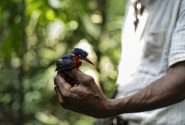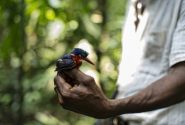By Stephen Leahy*

No economy or human well-being without nature. Ignorance of nature in economic system has been a major driver to vast species extinction. ©CIFOR/Ravi Prabhu
NAGOYA, Japan, Oct 28, 2010 (IPS) – One-fifth of all birds, fish and animals are threatened with extinction – as many as six million unique and irreplaceable forms of life – an authoritative new assessment warned Wednesday.
Deforestation, agricultural expansion, overfishing, invasive alien species and climate change are the specific causes, but the main engine of destruction is an economic system that is blind to the reality that there is no economy or human well-being without nature, experts here say.
“Without global conservation efforts the situation would be massively worse,” noted Simon Stuart, chair of the International Union for Conservation of Nature (IUCN) Species Survival Commission, which launched the study at the 10th Conference of the Parties to the Convention on Biological Diversity (CBD) in Nagoya, Japan.
Published in the peer-reviewed journal Science, it is the most comprehensive assessment ever done of the world’s vertebrates – mammals, birds, amphibians, reptiles and fishes – Stuart said.
Every year, 52 species of mammals, birds and amphibians move one step down a three-step path to extinction, according to the study, which utilised data for 25,000 species from the IUCN Red List of Threatened Species.
Southeast Asia has experienced the most dramatic recent losses, largely driven by the planting of export crops like oil palm, commercial hardwood timber operations, agricultural conversion to rice paddies and unsustainable hunting, the study found. Parts of Central America, the tropical Andes of South America, and even Australia have also all experienced marked losses, in particular due to the impact of the deadly chytrid fungus on amphibians.
“The backbone of biodiversity is being eroded,” said the eminent U.S. ecologist and writer Edward O. Wilson of Harvard University.
“One small step up the Red List is one giant leap forward towards extinction. This is just a small window on the global losses currently taking place,” Wilson said in a statement.
The term biodiversity and role of species is not well understood by the general public or policy makers. Biological diversity, better known as “nature”, refers to the plants, animals and microorganisms and their ecosystems that provide humanity with food, medicines, fresh air and water, shelter, and a clean and healthy environment in which to live.
“Nature’s backbone is indeed at risk,” said Julia Marton- Lefèvre, IUCN director general, who noted in a press conference here that one-third of all species are at risk of extinction. Another assessment of species, the Global Biodiversity Outlook 3, released last May found that one- quarter of plant species are threatened, the world’s corals and amphibians are in sharp decline, and the overall abundance of vertebrates had fallen by one-third in the past 30 years.
Despite this overwhelming evidence, most delegates here at what is in essence a “save nature to save ourselves” international negotiation are playing politics and have been unable to agree to specific targets. Last May, CBD science and policy advisors negotiated targets in Nairobi to protect 20 percent of the land and oceans by 2020. And that 20 percent target is less than what many experts had advocated.
New targets aiming to halt the loss of species mean nothing unless states address the cost and practicalities of reaching targets, say IUCN representatives. They have called for a massive increase in funding from the current three billion dollars a year to 300 billion dollars in annual public and private financing for biodiversity conservation. Not surprisingly, new financing is another major hurdle to overcome by Friday when negotiations conclude.
Representatives from the European Parliament told IPS that a substantial funding increase from Europe was highly unlikely beyond the one billion euros for biodiversity the European Union promised at the U.N. General Assembly in New York City in September.
“We are cutting budgets back home, it would be difficult to offer additional new money here,” said Jo Leinen, head of the European Parliament delegation and chair of the EP Committee on Environment.
Leinen, who also chaired one of the GLOBE (Global Legislators Organisation for a Balanced Environment) sessions on forests in Nagoya, told IPS that his group was urging the European Union to make long-term commitments on financing so funds will be available annually through the next decade.
More than 100 ministers of the environment arrived Wednesday, but that is not necessarily reason for hope. If conversations in the hallways here are any gauge, most ministers understand little about the role biodiversity plays in their countries’ social and economic well-being. And environment ministers are generally well below finance ministers in government hierarchies, limiting their influence.
Even the World Bank acknowledged this reality, when World Bank Group President Robert Zoellick addressed the opening of the ministerial segment of the conference Wednesday morning in Nagoya.
“Biodiversity is not an add-on. Preserving ecosystems and saving species are not luxuries for the rich. Conservation and development can go hand in hand. Our habitat and our planet deserve nothing less,” Zoellick told delegates.
The World Bank will refocus its efforts on the “financing of ecosystem and biodiversity services”, he said. More importantly, the Bank wants government ministries concerned with economic growth, infrastructure and overcoming poverty to be the champions of biodiversity conservation.
To make this happen, the Bank is launching a new global partnership Thursday to help governments integrate the true value of biodiversity and ecosystem services into their development planning and accounting systems.
“Conservation does work,” stressed IUCN’s Stuart, noting that in recent years some 64 species like the white rhino have been assisted in stepping back from the brink of extinction.
The study in Science showed definitively that declines would have been significantly worse without action. The conservation challenge is to protect species and ecosystems while protecting and/or enhancing the livelihoods of local people, he acknowledged.
*Stephen Leahy is a freelance journalist. He can be contacted at steve.leahy0@gmail.com. Or follow him on Twitter at http://twitter.com/StephenLeahy
We want you to share Forests News content, which is licensed under Creative Commons Attribution-NonCommercial-ShareAlike 4.0 International (CC BY-NC-SA 4.0). This means you are free to redistribute our material for non-commercial purposes. All we ask is that you give Forests News appropriate credit and link to the original Forests News content, indicate if changes were made, and distribute your contributions under the same Creative Commons license. You must notify Forests News if you repost, reprint or reuse our materials by contacting forestsnews@cifor-icraf.org.










